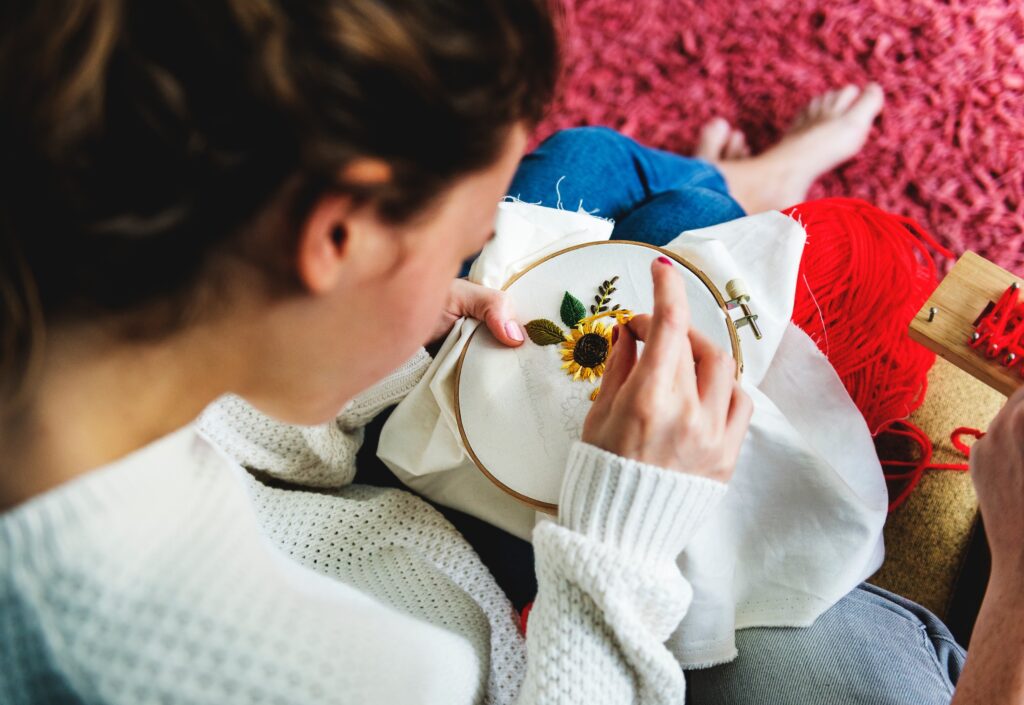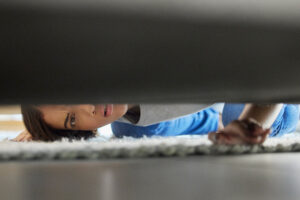Codependency can feel like a trap—constantly putting others first, struggling to say no, and measuring your worth by how much you’re needed. It can be difficult to recognize the signs, or know what to do once you’ve realized that you are in a codependent relationship.
If you are looking for a way to save your relationship, this guide may be just what you’ve been looking for. We will explain what a codependent relationship is, and how to overcome codependency.
In order to understand the dynamic of your relationship, you have to know what healthy and unhealthy relationships look and feel like. Healthy relationships consist of both parties giving and taking, whereas codependency is a toxic cycle of one person giving to feel needed. The other person is a taker and allows their partner to give without receiving anything in return.
So, what is codependency?
Codependency is a dysfunctional pattern of behavior in which one person relies heavily on the other for their emotional needs, often at the expense of your mental health. This can occur in any relationship between partners, family members, or friends. In this article, we will focus on a romantic partner dynamic. Feel free to adapt this information to whichever type of relationship you are experiencing this with.
Approximately 40% of the general population exhibits codependent behaviors to some degree, with about 25% of individuals seeking therapy report issues related to codependency. Codependency is a fairly common struggle for many, affecting the health of romantic and platonic relationships and leading to mental health struggles.
Signs of codependency (exhibited by the giver):
- Putting others’ needs before your own, often neglecting self-care
- Feeling responsible for other people’s feelings and actions
- Difficulty setting boundaries or saying no
- Constant need for approval and validation from others
- Difficulty expressing emotions or needs
- Guilt and anxiety when you cannot “fix” others’ problems
Signs of codependency (exhibited by the taker):
- Constant need for attention and validation from others
- Lack of self-sufficiency, relying heavily on others for emotional support
- Manipulative behavior to get what they want from the giver
- Difficulty taking responsibility for their actions
- Lack of empathy towards the giver’s needs and feelings
- Emotional or physical dependency on the giver.
Codependency is a complex issue that can have damaging effects on relationships. It is essential to recognize toxic relationship signs, decide to change, and seek help to maintain healthy relationships now and in the future. By recognizing codependency and working towards healthier relationship dynamics, we can break free from the cycle of dependence and create stronger connections.
Break up with codependency
When you realize that you are stuck in a cycle of unhealthy behaviors, you can start to address them and find the appropriate treatment to help guide your mental health and potentially create a more healthy dynamic within your relationship.
Now, this is much easier said than done. As a guide to a healthier you, here are some practical tips on how to stop being codependent:
The first and most crucial step is to recognize and acknowledge there is a problem. Codependency will not go away on its own. It is a behavior pattern that will repeat itself in different relationships until you address the root causes of the behavior. This will continue until the giver starts to set healthier boundaries.
Of course, you can break up with your partner. It will not resolve the underlying issue, though.

What does a healthy relationship look like?
What does a healthy relationship look like from this point forward? How often does a relationship survive from codependency to healthy relationship behaviors and dynamics?
The answer to this is different for everyone.
In order to understand how to overcome codependency and move into a healthy relational dynamic, you will both have to agree on some major changes, considering that new boundaries will have to be made. Those new boundaries may push on the relational dynamic, making the taker feel excluded, hurt, or rejected. If you are the giver in a codependent relationship, you will have to be willing not only to present new boundaries to your partner, but also enforce them.
In the end, you will both know what boundaries the other needs to be healthy and hopefully choose to respect them equally. If you decide to go your different ways, you will have learned more about yourself and what you need in a healthy relationship.
Here are ten signs of a healthy relationship:
- Communication: Healthy relationships involve open and honest communication, where you feel comfortable expressing your thoughts and feelings.
- Trust: A strong foundation of trust is crucial. You should feel secure, respected, and supported by the other.
- Independence: Each of you maintains your identity and has interests, hobbies, and friends outside of the relationship.
- Boundaries: Healthy relationships have clearly defined boundaries that are respected by both you and your partner. You understand and respect each other’s needs, limits, and values.
- Equality: This involves equal power dynamics, where you both have an equal say in decision-making and feel valued and respected by the other.
- Support: Both of you support and encourage each other’s personal growth, goals, and dreams.
- Compromise: When conflicts arise, you and your partner will participate in open communication and a willingness to compromise for the betterment of the relationship.
- Respect: Mutual respect is essential. Each of you should feel valued and respected by the other.
- Accountability: Healthy relationships involve taking responsibility for one’s actions and being accountable for your impact on the relationship.
Interdependence: There is a balance between independence and dependence. Each of you relies on the other for emotional support and fulfillment, maintaining your sense of self-worth and happiness.
Next, let’s look at some research-backed actionable steps you can take to jumpstart your efforts to overcome unhealthy behaviors within your relationship.
Toxic love is damaging to both people involved.
So, how do we move from codependence to interdependence?
1. Establish healthy and realistic boundaries
The main component that codependency thrives on is a need for more boundaries. When you do not have healthy boundaries to show others your limits, these lines are often crossed, putting you in an uncomfortable place. These limits are set to protect your mental and physical health and are essential to healthy relationships and self-care.
Boundaries are not set to hurt other people. They are meant to stop others from taking advantage of you and upholding your self-worth and care for yourself. If upholding your boundaries to your partner seems hurtful, you can consider this a red flag.
To learn more about how to set boundaries, read our article about creating and practicing boundaries here.
2. Try therapy
Healing from trauma looks different for everyone, and you may need to talk to someone about your relationship to learn healthier relational behaviors thoroughly.
Therapy gives you the necessary perspective on what your current relational dynamic looks like so that you can learn more about yourself, your partner, and what both of you need to be in a healthy relationship. It may also give you perspective on whether or not it is healthy for you both to stay in a relationship.
Therapy can give you a different point of view on your behavior and the workings of your relationship to see things more clearly. Makin Wellness offers individual and couples therapy. Our licensed therapists offer compassionate, personalized online therapy to help you recognize unhealthy behaviors and build healthy relationships.
3. Move away from negative coping patterns within your relationship
When your partner begins to break away from the cycle of codependency and starts to do the things on their own that you once did for them, do not take it personally or get upset. Instead, you should both put effort into recognizing negative coping patterns within your relationship. Some of these may look like blaming, stonewalling, being overly controlling, or doing things you’re uncomfortable with to please or satisfy the other person.
Remember that your partner still cares for you even if their behavior shifts to interdependence instead of codependence. People can learn to do things on their own without it being a direct threat to the relationship. Be proud of and happy for them instead of thinking you are no longer important to your partner.

4. Allocate personal time
Curing codependency includes shifting the focus from your partner to yourself. Learning how to focus on yourself will take effort and time, and you will feel much better when you do. Instead of depending on others to make you feel wanted, needed, and validated, you will soon start to fulfill those needs independently.
This may not be your first relationship experience with displaying codependent behaviors. This may be a lifelong pattern.
Many who struggle with codependent relationships have experienced childhood neglect, witnessed unhealthy communication patterns, or were in an emotionally chaotic home. It is helpful to recognize where we learned these behaviors from and why we still experience these types of relationships today. In knowing this information, we can move forward in an effort to break the cycles of unhealthy relationships.
Allocating time to yourself allows you to learn and reflect on past experiences that may inform the dynamics of this relationship. Taking time to yourself builds a sense of self and a sense of independence that can restore health to your codependent relationship. Choosing you means you are ready to break the cycle and start a healthy relationship with your partner to ensure the relationship can continue growing.
5. Understand what causes you to be in codependent relationships.
Another reason that you might cling to your codependency as tightly as you do is that you are uncomfortable with the idea of being alone. You might feel that constantly giving to someone will keep them needing you or show how important you are.
Breaking the cycle of codependency includes understanding why and how you end up where you are. Especially when you have experienced traumatic or difficult situations as a child, you may have learned that either no one will fulfill your needs or that you aren’t allowed to have them. As a human being, you naturally have needs and wants. This is a healthy thing to have. It is important to understand that we need to meet our own needs and wants. In addition to what we do for ourselves, people who genuinely care for you are happy and willing to help fulfill your needs and wants.
If you struggle with having needs and wants, this would be an area through which a licensed therapist can help you work.
Recultivate your sense of self without another person’s influence.
Giving so much to another person can cause us to lose sight of our individuality. What are some hobbies you once had but have stopped participating in? It is time to get back in touch with things that interest you and bring joy to your life.
Do you need help determining what hobbies or activities you may like? Throughout your life, you may experience many periods where you lose interest in something you once loved to do or become obsessed with an activity you once thought you would never like.Treat this as a discovery experiment or trial-and-error to find things that you love to do.
Here are some questions to ask yourself to recultivate your sense of self:
- What activities make me feel energized and excited?
- When do I feel most like myself and at peace?
- What activities can I do for an extended period without feeling burnt out?
- Do I prefer being alone or with others while engaging in these activities?
- How can I incorporate more of these activities into my daily life?
By exploring these questions, you can uncover activities you like or your life passions. Remember, it’s okay if it takes time to figure out. Your journey is unique; the most important thing is to keep an open mind as you explore this topic. There are no right or wrong activities. Go with whatever makes you feel happy.
What are some good therapy methods for remedying codependency?
Codependency is a complex issue that often requires professional help to address the root problems that created the need for codependency. At Makin Wellness, we have therapists available who are trained in different therapy techniques to help with relationship issues that you may be experiencing.
Therapies proven to help with codependency:
- Cognitive behavioral therapy (CBT): This therapy helps identify negative thoughts and behaviors and replace them with more positive ones. It also focuses on developing healthy coping mechanisms and addressing underlying issues that contribute to codependency.
- Dialectical behavior therapy (DBT): This therapy helps individuals regulate their emotions, improve interpersonal relationships, and develop mindfulness skills to reduce codependent behaviors.
- Group therapy: Group therapy provides a safe space for individuals to share their experiences with others who struggle with codependency. It also allows for a sense of community and support.
- Family therapy: Codependency often stems from dysfunctional family dynamics. Family therapy can help identify and address these patterns and improve communication within the family.
- EDMR: Eye Movement Desensitization and Reprocessing (EMDR) is a therapy that helps individuals process traumatic experiences that may be contributing to codependency.
Remember, seeking professional help for codependency is not a sign of weakness. It takes courage to address and overcome these issues that likely have been repeating themselves for many years. Learning how to overcome codependency takes time and effort. With the right therapy and support, it is possible to stop this cycle of behavior.
Can I save my relationship?
For a relationship to go from unhealthy to healthy and survive the drastic change takes dedication and effort from both partners. It also takes honesty and willingness to admit where there were previous faults and your contribution to the dynamic. This can be difficult. The power that comes from acknowledging you and your partner’s part in all of this can be a massive reason for your success after this significant change.
Is it possible to salvage a former codependent relationship? Of course. There is always room for lasting love when backed up with the foundations of a healthy relationship. As long as you both work on yourselves, improvements can be made.

Conclusion
Learning how to overcome codependency is a journey that requires self-reflection, understanding, and support. It’s essential to recognize toxic relationship signs and behaviors contributing to codependency and work towards establishing healthy boundaries, self-worth, and identities outside of each other.
Therapy can provide a safe and supportive space for you to explore your experiences, emotions, and thought patterns related to codependency. A licensed therapist can offer tools and guidance to help you break free from unhealthy patterns and build healthier relationships.
If you’re ready to change your life and learn how to overcome codependency, , make an appointment or call us at (833)-274-heal to connect with a specialized therapist.









This Post Has One Comment
Great blog post! I’ve been struggling with codependency for years and this article has really helped me to see the signs and to start to overcome it. Thank you!